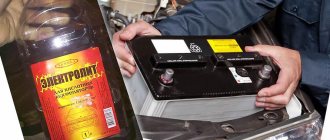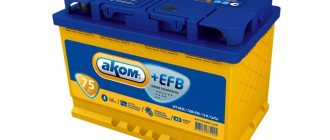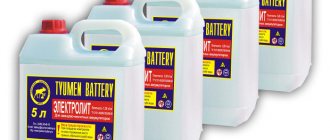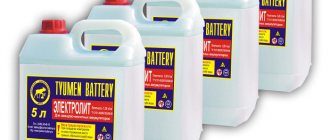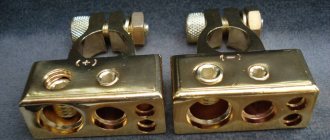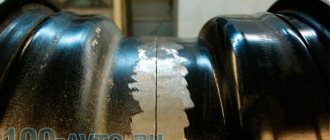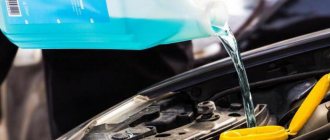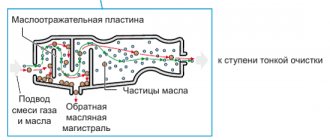Electrolyte is one of the main components of batteries that make it possible to start a car. It comes in several types, differing in their composition. Timely monitoring of the quantity and quality of electrolyte in the battery will avoid premature battery failure and save on the purchase of a new device.
Types, composition and features
At the moment, there are three types of electrolytes for batteries, for alkaline batteries - alkaline, and for acid batteries - acidic, but also a corrective electrolyte is also isolated, which is necessary when servicing batteries.
How to determine whether a battery is acidic or alkaline? The easiest way to do this is by the marking of the case and the material from which it is made. The housing of acid batteries is always made of special plastic, while alkaline batteries can be made of metal. You can also determine by testing a drop of electrolyte from the battery: the acidic electrolyte will react with soda or chalk.
Acid
It is a mixture of sulfuric acid, which makes up thirty-five percent of the total composition, and distilled water, which occupies the remaining sixty-five.
This composition in the battery is located in a container with lead plates, and when these elements come into contact, current is generated.
Advantages of acid electrolyte:
- High level of efficiency
- Slight loss of charge during inactivity
- High starting current output
- Low cost
Flaws:
- Sensitivity to temperature changes
- Not environmentally friendly
- The need for regular monitoring of composition density
It should be noted that acid electrolyte is used in most car battery models, since only it is capable of providing enough current to start the engine. In this case, batteries manufactured using this solution are divided into two groups:
- Serviced
- Maintenance-free
The first type provides easy access to the contents of the cans. You can measure the density of the electrolyte in them, and, if necessary, add distilled water and electrolyte by simply unscrewing the lids from the jars.
In the case of maintenance-free models, it is also possible to carry out similar actions, but to do this you need to open the device yourself, carry out the necessary actions, and then close them hermetically. In such cases, a drill and welding machine can be used.
It is worth replacing the electrolyte in maintenance-free models only in cases where their warranty period has expired. Often this is done solely to gain experience in conducting such operations.
Alkaline
An alkaline electrolyte consists of potassium hydroxide, sodium hydroxide, lithium hydroxide, or all of these combined, diluted in water.
The advantages of this type include:
- Long service life
- Ability to maintain properties under significant temperature changes
- Much less emissions of harmful gases into the atmosphere
- Ability to withstand shocks
- Easy to maintain
Flaws:
- Lower electromotive force compared to acidic ones
- Lack of ability to supply starting current to start the engine
- Higher cost
Despite the long service life, unpretentiousness and other advantages, the use of this type of electrolyte in the automotive industry is limited. This is due to the inability to generate a sufficient level of starting current necessary to start the engine. The disadvantages also include their impressive dimensions.
This is interesting: Car gel batteries - pros and cons of technology
However, devices based on alkaline electrolyte are successfully used to supply current to traction and locomotive trains.
Important! Before replacing, make sure that the battery is alkaline. Otherwise, the battery can be completely damaged.
Corrective
This electrolyte is a special composition with a high content of active substances, used to increase the density of the battery electrolyte. It is designed to increase the concentration of active substances in the battery.
The following types of corrective electrolyte can be found on sale:
- Solid potassium-lithium
- Liquid potassium lithium with different densities
- Liquid acid
Corrective electrolyte can be made independently , having on hand the necessary compositions for this, but it is often easier to buy it, since its cost is more than affordable.
How to use correction electrolyte:
- Remove some electrolyte from the jars
- Add the same amount of correction fluid to them.
- Set the battery to charge the rated current to start the process of mixing the resulting composition for half an hour
- Leave the battery to cool for a couple of hours
- Measure the density and adjust it again if necessary.
When repeating correction, the amount of electrolyte to be replaced should be reduced.
Electrolyte in a charged battery
During discharges, the density of the electrolyte may decrease. This happens because the acid, combining with lead, settles in the form of sulfates on the plates. As soon as you recharge the battery, sulfates begin to disintegrate and the concentration is restored.
However, during deep discharges , sulfates form large crystals, which simply pack the plates, and the density drops critically.
Some owners, in order to increase the density, add an electrolyte inside with the desired concentration, or even worse, a “concentrate”! DO NOT do this! Because the sulfate crystals have not disintegrated (that is, the plates are packed), and you make the situation even worse by adding concentrated electrolyte.
If this happens to you, you need to use methods of either desulfating or reversing your battery .
Now we are watching a small but useful video.
This is where I end, I think my article was useful to you, sincerely your AUTOBLOGGER.
Similar news
- Car gel batteries
- Is it possible to remove the battery from a car (foreign car). Let's say for the winter...
- How to extend battery life. And why does it quickly discharge...
Add a comment Cancel reply
How to cook it yourself
Before you replace the battery electrolyte yourself, you must take appropriate safety measures and prepare personal protective equipment:
- Gloves
- Apron
- Protective glasses
- Soda solution in case of contact with skin or clothing
- Vinegar or citric acid - to neutralize alkali
Actions should be carried out in a well-ventilated area with an air temperature no higher than +25 C°. You should know in advance how much ready-made electrolyte will be required to fill the batteries. On average, in modern batteries the amount of solution ranges from 2.6 to 3.7 liters. Therefore, you should immediately focus on the maximum quantity. You can use 4 liters of the final solution as a basis.
To prepare the electrolyte, you must prepare the following items in advance:
- Utensils of sufficient capacity, made of material resistant to acid and alkali
- A small stick for stirring the electrolyte
- Tools for measuring density, temperature and solution level
- For an acid electrolyte - sulfur liquid, for an alkaline electrolyte - alkali in solid or liquid form, lithium or silica gel
Important! All materials used must be chemically neutral to avoid the occurrence of unnecessary reactions upon contact. Ordinary glass jars are quite suitable as containers.
The process of preparing alkaline electrolyte
The ingredients for the preparation of this composition can be either in liquid or solid form. If everything is clear with the first one, then before pouring, the alkaline electrolyte from the solid will need to be diluted in distilled water.
The required density is indicated on the battery manufacturer's website, and information can also be found in the attached operating instructions. The solid electrolyte is taken in proportion to the required amount of the final liquid solution and is:
- 1/5 – to obtain a solution with a density of 1.17-1.19 g/m³
- 1/3 – for a solution with a density of 1.19-1.21 g/m³
- 1/2 - for a solution with a density of 1.25-1.27 g/m³
The cooking process consists of the following steps:
- Pour distilled water into the bowl
- Add the required amount of alkali
- Stir the solution
- Close the lid tightly
- Leave for 6 hours
After the infusion process is completed, it is necessary to drain the light solution. If part of the composition precipitates, you need to stir it regularly. When filling, you need to make sure that it remains at the bottom and does not get into the battery, otherwise it threatens to cause the battery to fail.
This is interesting: Ways to use solar energy
Preparation of a solution for lead batteries
Before diluting the acid electrolyte, it is necessary to determine the required proportions. They depend on the climatic conditions in which the device is planned to be used.
To obtain an electrolyte with a density of 1.28 g/m³, which is acceptable for average climatic conditions, you will need to pour 0.36 liters of sulfuric acid into one liter of distilled water. For hot regions, the amount of sulfuric acid is reduced to 0.33 liters for the same amount of water.
How to dilute battery acid:
- Pour distilled water into the prepared container
- Carefully pour the acid into it in a thin stream.
- Measure the density of the resulting solution
- Leave the solution to infuse for 12 hours
Important! You can't pour water into acid! That's right - pour acid into water. Do not rush into adding acid; allow it to gradually dissolve in the water.
A few words about alkaline electrolyte
July 3, 2021 Reading time: It's no secret that modern batteries run on electrolyte.
This substance allows batteries to accumulate charge and release it in the form of final electricity during operation. One of the most common electrolytes is alkaline, which is actively used in batteries of the same name. This substance works well in battery operation, but also has some disadvantages.
We will talk in more detail about them, the essence of the alkaline electrolyte and the principles of its operation in today’s article. Alkaline electrolyte is one of the main components of batteries of the same name. Today, a similar substance is used in many batteries, so the relevance of its consideration is quite high.
The typical electrolyte composition for alkaline batteries is:
- or from caustic potassium and lithium compounds;
- or from sodium hydroxide and potassium hydroxide, as well as the same lithium.
Any of the compounds noted above in a certain concentration is diluted with distilled water, which forms an electrolyte solution for alkali.
In terms of formation, it is liquid and appears, at first glance, as ordinary water. At the moment, in the field of rechargeable batteries, there are two typical, competing types of electrolytes, namely:
- those we are considering are alkaline;
- and acidic.
The former, compared to the latter, are more reliable and durable battery components. Besides,
Replacement instructions
The electrolyte is replaced in the following cases:
- The electrolyte in the jars changed color and became cloudy. The reason for this may be the use of non-distilled water for the additive, but usually. It may contain impurities that react chemically with the electrolyte and form solid compounds that precipitate
- After charging the battery, it is impossible to achieve the desired density
- Electrolyte leaked due to negligence
- The new battery drains quickly. The reason for this may be freezing of the solution
Replacing the electrolyte, regardless of whether it is alkaline or acidic, is carried out in several steps:
- Removing the battery from the vehicle
- Cleaning the battery from contamination
- Pumping out existing fluid using a bulb or syringe
- Rinsing jars with distilled water
- Filling electrolyte using a bulb or similar devices
The fill level is determined by marks inside the cans. If they are missing, you need to follow the rule - the electrolyte should be 5-7 millimeters above the plates. At the same time, at least two centimeters should remain from its level to the lids of the cans.
When draining the electrolyte, it is very important not to tilt it to the side, much less turn it over. There may be solid particles at the bottom of the vessels that will get stuck in the plates, completely rendering them inoperable. It is allowed to gently rock the water from side to side when washing; the same actions can be performed after filling the electrolyte into the battery.
After this, the battery is installed for charging, after which the resulting density should be checked. Measurements should be taken no sooner than a couple of hours after removing the device from charging, as there is a risk of getting inflated readings. If the density is not high enough or, on the contrary, has excessive values, it should be adjusted by adding acid, alkali or distilled water.
Helpful operating tips
Distilled water or electrolyte
In order not to wonder whether it is possible to change the electrolyte in the battery, it is better to properly monitor its condition and take into account the basic operating rules. One of the most important is ensuring a balanced temperature regime: when the temperature drops to certain levels, the acid can freeze.
The minimum density of the battery at temperatures up to minus 30 degrees Celsius should be equal to 1.29 g. If the temperature is lower - up to 1.32 g. If there are no optimal indicators, then you will have to restore them by adding sulfuric acid.
The fact is that an electrolyte with a lower density will very quickly freeze and become unsuitable for further use, since any chemical processes will cease to take place in it. As density increases, the freezing point decreases. If it so happens that ice appears inside the battery, you can only hope that it did not deform the lead plates. If damage occurs, the battery will have to be repaired or completely replaced.
Knowing how to properly change the electrolyte in a battery, you can avoid the need to contact a service center and overpay for expensive repairs.
Alkaline electrolyte: rules of use
It's no secret that modern ones run on electrolyte.
This substance allows batteries to accumulate charge and release it in the form of final electricity during operation. One of the most common electrolytes is alkaline, which is actively used in batteries of the same name. This substance works well in battery operation, but also has some disadvantages.
We will talk in more detail about them, the essence of alkaline electrolyte and the principles of its operation in today’s article. Alkaline electrolyte is one of the main components of rechargeable batteries of the same name.
Today, a similar substance is used in many batteries, so the relevance of its consideration is quite high. The typical electrolyte composition for alkaline batteries is:
- or from sodium hydroxide and potassium hydroxide, as well as the same lithium.
- or from caustic potassium and lithium compounds;
Any of the compounds noted above in a certain concentration is diluted with distilled water, which forms an electrolyte solution for alkali. In terms of its formation, it is liquid and, at first glance, appears to be ordinary water. At the moment, in the field of rechargeable batteries, there are two typical types of electrolytes that compete with each other, namely:
- And .
- those we are considering - ;
The former, compared to the latter, are more reliable and durable battery components.
In addition, alkaline electrolytes are superior to acidic ones in many respects, with the exception of one BUT - they are not capable of producing a starting current.
